Film Library - Jazz Age Dance
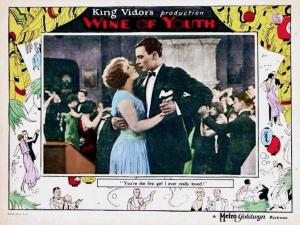 The core of my research into the social dances of the Jazz Age has been old films. In the process, I have assembled a fairly extensive library of film clips, edited down for use in online and in-person instruction. Much of it, due to the perils of copyright and YouTube's draconian policies, I have had to keep off the Internet, but much of it I can share.
The core of my research into the social dances of the Jazz Age has been old films. In the process, I have assembled a fairly extensive library of film clips, edited down for use in online and in-person instruction. Much of it, due to the perils of copyright and YouTube's draconian policies, I have had to keep off the Internet, but much of it I can share.
Here is my online film library. Most of these are already embedded in web pages that address particular dance styles, but here they are for those who wish to focus on the films, unencumbered by my ramblings and random observations.
A Fox-Trot Evening in Paris in 1929
This was trimmed down from Fox Movietone News out takes of an evening at a Paris nightclub in 1929. The sound was pretty bad so I superimposed a French band number.
This was done in support of a "Fox Trot in the 1920s" workshop I gave in DC in May 2016.
Same-Sex Social Dancing in the Jazz Age
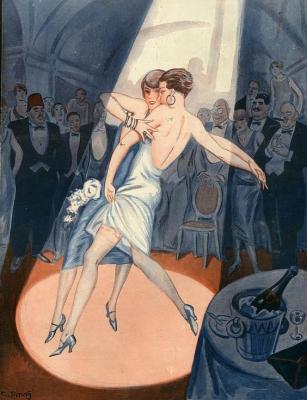 A few years back, someone posted a video on Facebook of folks dancing at the Queen Mary Art Deco Festival, and among the dancers were two women dancing together. One of the commenters, with the best of intentions, posted something about the women "embracing their sexuality". The commenter was answered by someone who had attended my lecture where I had pointed out that women dancing with women was very common in the Jazz Age, and that one shouldn't infer too much from that. The second commenter was particularly correct in that the two women in question were mother and daughter, and there was no sexuality-embracing going on there at all.
A few years back, someone posted a video on Facebook of folks dancing at the Queen Mary Art Deco Festival, and among the dancers were two women dancing together. One of the commenters, with the best of intentions, posted something about the women "embracing their sexuality". The commenter was answered by someone who had attended my lecture where I had pointed out that women dancing with women was very common in the Jazz Age, and that one shouldn't infer too much from that. The second commenter was particularly correct in that the two women in question were mother and daughter, and there was no sexuality-embracing going on there at all.
This does however, highlight how our views and assumptions have changed. We live today in a world that jumps to a sexually based inference as something of a default. While the people of the Jazz Age were far from innocent, there was a certain innocence in their tendency to not assume a sexual element when people danced with each other.
This applies equally to opposite and same gender dancing. The dance holds of the Jazz Age were very close. They were body-to-body, and the open frame stance of today was completely out of fashion. In this hold, which we today generally see only in "Blues" dancing, Argentine Tango and High School slow dances, men and women routinely danced with multiple partners: spouses, lovers, friends and strangers - and seemed to take in stride a level of physical intimacy that many people today find a bit uncomfortable. Further, the social mores of the time held that it was tedious and unsociable for couples to dance exclusively with one another, so it was generally accepted that this intimate hold would be practiced rather promiscuously within one's social circle.
Dance Etiquette - 1926
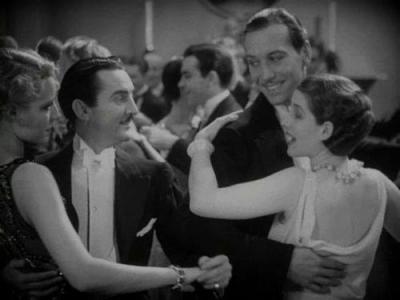 From Washington Post/Vogue Column: Conduct and Common Sense. 1926
From Washington Post/Vogue Column: Conduct and Common Sense. 1926
Some practical advice on how to behave in the Jazz Age/Roaring Twenties.
Husbands and Wives
In society, husbands and wives consider a ball or dance, or, indeed, any form of entertainment, the occasion for seeing their old friends and acquaintances and making new ones, not for staying together. At dinners they are separated as far as possible, to give them both a chance to express themselves as individuals, not as halves of a never-to-be-divided whole. At dances, though a couple who happen to like dancing together may, and do often, take a turn, the etiquette of the evening is that they should both have too many partners to be able to see much of each other. If they are seen constantly together, the idea conveyed to onlookers is that they don't know many people and are not having a much gayer time than they would have together at home. This may be far from the case, but the impression is conveyed all the same. Married men and women go out to see people, not to be with each other.
Of course, this supposes that the places they go to are places where they are surrounded by friends and acquaintances. That is what society is--the meeting of amusing people in amusing places. But if a man and his wife found themselves at a dance where they knew few, if any, people, they would most naturally take advantage of a good floor and good music to dance together. This would be sensible and enjoyable, but etiquette would not be involved. A man should dance with his hostess at any ball, once or twice during the evening, but he need not (and often could not), make his first dance the one with her. He might dance first with his wife. If some one else did not ask her at once, but it would not be obligatory.
Argentine Tango - 1934: Dance Scenes from Questa Abajo with Carlos Gardel
I have extracted the two Argentine Tango scenes from this Carlos Gardel film
Jazz Age Lead and Follow
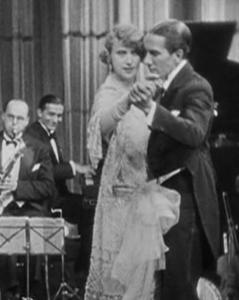 The Jazz Age ballroom style, a style I like to refer to as "Cocktail Dancing", is unique in its simplicity, intimacy and freedom. It is the dance of an age when everyone danced, when people were participants rather than just spectators in their own entertainment.
The Jazz Age ballroom style, a style I like to refer to as "Cocktail Dancing", is unique in its simplicity, intimacy and freedom. It is the dance of an age when everyone danced, when people were participants rather than just spectators in their own entertainment.
What follows are some helpful hints for dancing in this style.
The Lead
In this style of dancing, very little of the lead comes from your hands and arms, and most of it from your body - your "core". Since you are in body to body contact, the two of you should move effortlessly as a unit.
The desired effect is smoothness and musicality. The Lead should adapt to the music, dancing smooth and romantic when the music is smooth and romantic, and exuberantly when the dance is exuberant. He should sway and move his body to the music and convey that movement to his partner. The movement starts with the shoulders and works its way down as the body follows the shoulders.
However, being in such close contact imposes some constraints. Your movements can't be too violent or broad, your feet can't do anything that would cause stepped on feet or colliding knees and since you are so close together (perhaps even cheek-to-cheek) unless your partner is so short that her head is below your sight line, you can't really see that well, so Polka-style hurtling across a crowded dance floor could be a very bad idea.
"Cocktail Dancing": What's in a Name?
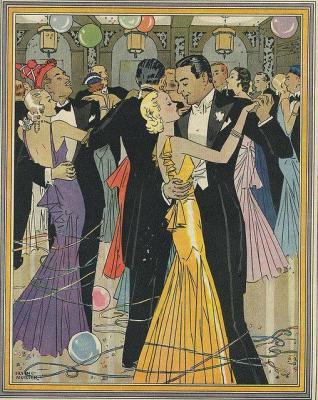 As anyone who has seen my social media posts for the last couple of years will know, I have been focused on recreating the social dances of the 1920s, 30s and â40s â not the youth dances like Charleston and Swing (they donât need my help) but the, at the time, far more widely danced Foxtrots, Waltzes and Tangos.
As anyone who has seen my social media posts for the last couple of years will know, I have been focused on recreating the social dances of the 1920s, 30s and â40s â not the youth dances like Charleston and Swing (they donât need my help) but the, at the time, far more widely danced Foxtrots, Waltzes and Tangos.
I have come to the conclusion that this style of dance I have been advocating is really its own style, distinct from modern ballroom, swing dance etc. It really needs its own name.
These dances, in their original forms, were far less structured, far less strictly defined, far more intimate and far easier than their current âDancing With the Starsâ or "International Ballroom" forms. It is a style of dance that I think has a lot to offer our modern world, and I would love to see it revived and spread beyond a narrow, historical dress-up sort of audience.
At the time, these dances were called âThe Modern Dancesâ, but âModern Danceâ is a term that has become inextricably associated in our own time with styles of artistic performance dance â successors to ballet, so âModern Danceâ is pretty much taken, and another name is required to describe this unique style. Besides, âmodernâ is an adjective that has something of a set âsell byâ date, and becomes just a bit ironic when applied to a dance style thatâs about a century old.
I have been referring to them as âJazz Age Social Dancesâ, which sets them in their proper historical context, but also locks them into the past. It defines them as a museum artifact. Itâs as if you called Swing Dancing âGreat Depression Dancingâ or âWorld War Two Dancingâ.
I suspect a hard-wired link to the past could be impediment to a broader acceptance of this sort of dancing.
So, what can we call this style, with its focus on social connection, simple enjoyment and sophistication, that conveys its unique spirit and essence?
Dancing in A Dockside Dive in 1928
This scene, in which dancing figures prominently in the background, gives a sense of the sorts of dancing a movie audience would expect to see in a sleazy dive in New York in 1928. It's from "The Docks of New York"

